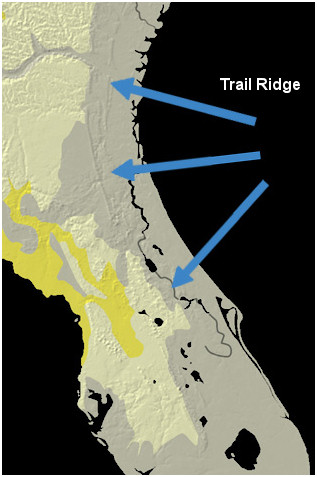|
Triodopsis species "Florida Scrub Threetooth" |
|
|
|
|
 Based upon the Florida Museum of Natural History on-line
database (FLMNH 267942), the Triodopsis population at the Camp Blanding Training Area
in southwestern Clay County, Florida was probably initially discovered by Dr. Marc Minno in March, 1995 as he was engaged in a survey of
butterflies and
aquatic insects on the installation. At that time he
found nine empty shells in Rosemary Scrub 1,500 feet
south of Fort Lauderdale Street between Avenues A and B. This
reporters follow-up site visits during 2013, some 18 years later, found the species
(both empty shells and live specimens) at the same location as
reported by Dr. Minno as well as other locations encompassing a
four block area. However, only empty shells have thus far been
found in two of the four blocks.
Map showing distribution of Triodopsis
species on northern Camp Blanding Based upon the Florida Museum of Natural History on-line
database (FLMNH 267942), the Triodopsis population at the Camp Blanding Training Area
in southwestern Clay County, Florida was probably initially discovered by Dr. Marc Minno in March, 1995 as he was engaged in a survey of
butterflies and
aquatic insects on the installation. At that time he
found nine empty shells in Rosemary Scrub 1,500 feet
south of Fort Lauderdale Street between Avenues A and B. This
reporters follow-up site visits during 2013, some 18 years later, found the species
(both empty shells and live specimens) at the same location as
reported by Dr. Minno as well as other locations encompassing a
four block area. However, only empty shells have thus far been
found in two of the four blocks.
Map showing distribution of Triodopsis
species on northern Camp BlandingOn 4/30/2013 scientific advisor Dr. Harry Lee visited the Florida Museum of Natural History in Gainesville, Florida and reviewed their holdings of the genus Triodopsis (nearly 1200 lots). During his review he identified eight additional lots of shells that are the same as the Camp Blanding snails. The seven additional sites where this snail has been found included Keystone Heights (Clay Co. - two locations/lots [1969 and 1977]) Lake Lily (Clay Co. [1984]), Melrose area (two locations/lots - one from Putnam Co. [1988] and one from Clay Co. [1971]), Ordway Preserve (Putnam Co. [1987]), and two lots purportedly collected from a single location in downtown Gainesville (Alachua Co. [1954]). The Alachua County locality records are suspect. Exclusive of the Gainesville records, the sites where the snails have been found conform to the Trail Ridge Formation on roughly a north to south axis for a distance of about 21 miles. Trail Ridge, the largest of several long, low north-trending ridges in central Florida, is among the most distinctive landforms in our area of generally low topographic relief. The ridges are complexes of sand dunes formed during the Pleistocene, when the coastline was some 60 feet higher than it is today. The sandy sediments were eroded from rocks of the Appalachian highland to the north. |
|
| Excluding the questionable Alachua County records, the map below depicts those locations where the Triodopsis species has thus far been found. The map includes those locations mentioned above as well as additional locations that have been discovered by this reporter and Dr. Harry Lee while conducting field surveys during May-July, 2013. | |
|
|
|
|
Map and full details of all Triodopsis species discoveries in the Keystone Heights area (north) |
|
|
Map and full details of all Triodopsis species discoveries in the Melrose area (south) |
|

